Hello! When Preparing For A Mission What Are Your Primary Concerns For The Astronauts Safety- What Do
Hello! When preparing for a mission what are your primary concerns for the astronauts safety- what do you focus on with the most intensity to feel confident in sending a crew up?
More Posts from Nasa and Others
Have you seen Hidden Figures? What did you think
I have seen Hidden Figures, and I was very proud that NASA supported the telling of the story. Despite the circumstances of the time, it shows that we worked well together to get a human being in space.
Vote for Your Favorite Astronaut Picture: Tournament Earth 2021
It is that time of year again…Tournament Earth is back! This year, NASA Earth Observatory has chosen a new theme for the tournament: astronaut photography. Choose your favorite image here.

For more than 20 years, astronauts have been shooting photos of Earth from the International Space Station that highlight the planet’s beauty, complexity, and vulnerabilities. So which are the most unforgettable ones? Over the next five weeks (March 8-April 13), you can help decide.
How can you get involved? It's easy as 1…2…3!
1. Read and Vote.
Not sure which image to vote for because they are ALL so captivating? Read the intriguing stories behind the images to help you decide! You can access the stories by clicking on the image headlines on the voting page: https://earthobservatory.nasa.gov/tournament-earth
For instance, the Stars in Motion image is actually a compilation of 72 photographs. And some of the night lights around Bangkok, Thailand, actually show fishing boats as well as city lights.
2. Fill out your bracket.
Think you know which photo will win it all? Fill out a #TournamentEarth bracket with your predictions and challenge friends! Then share your predictions with NASAEarth on our blog, Twitter, Facebook, Instagram, or right here on Tumblr!
We can't offer a trip to the Moon, but bragging rights are forever if you can pick the champion. Download a more print-friendly version of the bracket here.

3. View the results…and vote again!
Tournament Earth will have five rounds, and round one is currently underway. Voting for the following rounds begins on Tuesdays and will be open for six days. We will update our social media channels (including right here on Tumblr!) with the newest matchups. Check this space to see how your favorite images did. Then vote until we crown a champion on April 13, 2021.

See all of the images and vote HERE. Follow @NASAEarth on social media for updates.
Make sure to follow us on Tumblr for your regular dose of space: http://nasa.tumblr.com
Morning Jeanette. My 10 year son old recently told me his dream job that he would love to do is to become an Astronaut or be apart of a team that builds a spaceship. What is your best suggestion for me as his parent to help expose him to know what life is like for an astronaut and how much work did you put in your education to help you solidify your career that I can use as encouragement for him? Thanks again and you're AWESOME.
I spent 11 and a half years in school after high school, so I tell this to students because it takes a lot of investment in educating yourself. Then even beyond that, gaining experiences that are meaningful. After graduate school, working at Ford Motor Company and the CIA really taught me how to be a detailed scientist as well as working operationally in the field. I also did internships to help hone and sharpen skills as an engineer. I was happy with my career, and then I applied.
What’s Up for November 2016
What’s Up for November: Venus at sunset, Jupiter at dawn, your last evening glimpse of Saturn until spring, and more meteors!

Through November 3, catch glimpses of a gibbous Venus, a crescent moon and ringed Saturn in the southwest sky just after sunset.

Wake up before sunrise every day this month to see Jupiter just above Spica, the brightest star in the constellation Virgo, shining in the east-southeast sky.
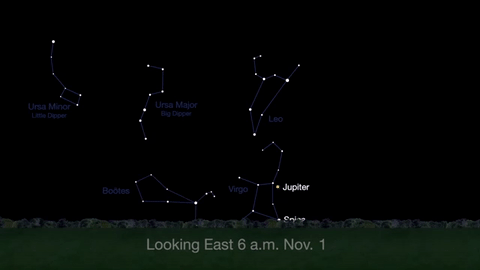
Just before dawn on November 23-24, see the waning crescent moon just above Jupiter.
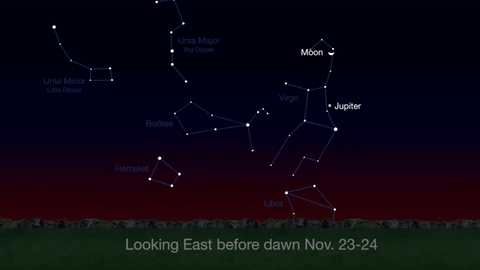
November is a great time to see the constellation Ceres as it glides past Cetus, the Whale and you will be able to see the dwarf planet move relative to the background stars, but you’ll need a telescope for this one.
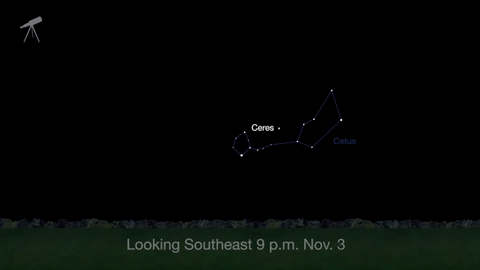
This month, just like last month, there will be three meteor showers--the Northern Tuarids, the Leonids and the November Orionids.
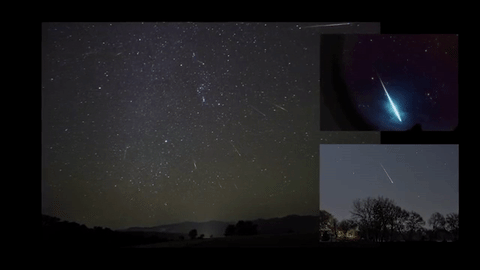
Watch the full November “What’s Up" video for more:
Make sure to follow us on Tumblr for your regular dose of space: http://nasa.tumblr.com.
Make Sure You Observe the Moon on October 20
On Saturday, October 20, NASA will host the ninth annual International Observe the Moon Night. One day each year, everyone on Earth is invited to observe and learn about the Moon together, and to celebrate the cultural and personal connections we all have with our nearest celestial neighbor.
There are a number of ways to celebrate. You can attend an event, host your own, or just look up! Here are 10 of our favorite ways to observe the Moon:
1. Look up

Image credit: NASA’s Scientific Visualization Studio/Ernie Wright
The simplest way to observe the Moon is simply to look up. The Moon is the brightest object in our night sky, the second brightest in our daytime sky and can be seen from all around the world — from the remote and dark Atacama Desert in Chile to the brightly lit streets of Tokyo. On October 20, the near side of the Moon, or the side facing Earth, will be about 80 percent illuminated, rising in the early evening.
See the Moon phase on October 20 or any other day of the year!
2. Peer through a telescope or binoculars

The Moon and Venus are great targets for binoculars. Image Credit: NASA/Bill Dunford
With some magnification help, you will be able to focus in on specific features on the Moon, like the Sea of Tranquility or the bright Copernicus Crater. Download our Moon maps for some guided observing on Saturday.
3. Photograph the Moon

Image credit: NASA/GSFC/ASU
Our Lunar Reconnaissance Orbiter (LRO) has taken more than 20 million images of the Moon, mapping it in stunning detail. You can see featured, captioned images on LRO’s camera website, like the one of Montes Carpatus seen here. And, of course, you can take your own photos from Earth. Check out our tips on photographing the Moon!
4. Take a virtual field trip

Image credit: NASA/JPL-Caltech
Plan a lunar hike with Moontrek. Moontrek is an interactive Moon map made using NASA data from our lunar spacecraft. Fly anywhere you’d like on the Moon, calculate the distance or the elevation of a mountain to plan your lunar hike, or layer attributes of the lunar surface and temperature. If you have a virtual reality headset, you can experience Moontrek in 3D.
5. Touch the topography

Image credit: NASA GSFC/Jacob Richardson
Observe the Moon through touch! If you have access to a 3D printer, you can peruse our library of 3D models and lunar landscapes. This model of the Apollo 11 landing site created by NASA scientist Jacob Richardson, is derived from LRO’s topographic data. Near the center, you can actually feel a tiny dot where astronauts Neil Armstrong and Buzz Aldrin left the Lunar Descent Module.
6. Make Moon art

Image credit: LPI/Andy Shaner
Enjoy artwork of the Moon and create your own! For messy fun, lunar crater paintings demonstrate how the lunar surface changes due to consistent meteorite impacts.
7. Relax on your couch

Image credit: NASA’s Scientific Visualization Studio/Ernie Wright
There are many movies that feature our nearest neighbor, from A Voyage to the Moon by George Melies, to Apollo 13, to the newly released First Man. You can also spend your evening with our lunar playlist on YouTube or this video gallery, learning about the Moon’s role in eclipses, looking at the Moon phases from the far side, and seeing the latest science portrayed in super high resolution. You’ll impress all of your friends with your knowledge of supermoons.
8. Listen to the Moon
Video credit: NASA’s Scientific Visualization Studio/Ernie Wright
Make a playlist of Moon songs. For inspiration, check out this list of lunar tunes. We also recommend LRO’s official music video, The Moon and More, featuring Javier Colon, season 1 winner of NBC’s “The Voice.” Or you can just watch this video featuring “Clair de Lune,” by French composer Claude Debussy, over and over.
9. See the Moon through the eyes of a spacecraft

Image credit: NASA/GSFC/MIT
Visible light is just one tool that we use to explore our universe. Our spacecraft contain many different types of instruments to analyze the Moon’s composition and environment. Review the Moon’s gravity field with data from the GRAIL spacecraft or decipher the maze of this slope map from the laser altimeter onboard LRO. This collection from LRO features images of the Moon’s temperature and topography. You can learn more about our different missions to explore the Moon here.
10. Continue your observations throughout the year

Image credit: NASA’s Scientific Visualization Studio/Ernie Wright
An important part of observing the Moon is to see how it changes over time. International Observe the Moon Night is the perfect time to start a Moon journal. See how the shape of the Moon changes over the course of a month, and keep track of where and what time it rises and sets. Observe the Moon all year long with these tools and techniques!
However you choose to celebrate International Observe the Moon Night, we want to hear about it! Register your participation and share your experiences on social media with #ObserveTheMoon or on our Facebook page. Happy observing!
Make sure to follow us on Tumblr for your regular dose of space: http://nasa.tumblr.com.
Infrared is Beautiful
Why was James Webb Space Telescope designed to observe infrared light? How can its images hope to compare to those taken by the (primarily) visible-light Hubble Space Telescope? The short answer is that Webb will absolutely capture beautiful images of the universe, even if it won’t see exactly what Hubble sees. (Spoiler: It will see a lot of things even better.)

The James Webb Space Telescope, or Webb, is our upcoming infrared space observatory, which will launch in 2019. It will spy the first luminous objects that formed in the universe and shed light on how galaxies evolve, how stars and planetary systems are born, and how life could form on other planets.
What is infrared light?
This may surprise you, but your remote control uses light waves just beyond the visible spectrum of light—infrared light waves—to change channels on your TV.
Infrared light shows us how hot things are. It can also show us how cold things are. But it all has to do with heat. Since the primary source of infrared radiation is heat or thermal radiation, any object that has a temperature radiates in the infrared. Even objects that we think of as being very cold, such as an ice cube, emit infrared.
There are legitimate scientific reasons for Webb to be an infrared telescope. There are things we want to know more about, and we need an infrared telescope to learn about them. Things like: stars and planets being born inside clouds of dust and gas; the very first stars and galaxies, which are so far away the light they emit has been stretched into the infrared; and the chemical fingerprints of elements and molecules in the atmospheres of exoplanets, some of which are only seen in the infrared.
In a star-forming region of space called the 'Pillars of Creation,' this is what we see with visible light:

And this is what we see with infrared light:

Infrared light can pierce through obscuring dust and gas and unveil a more unfamiliar view.
Webb will see some visible light: red and orange. But the truth is that even though Webb sees mostly infrared light, it will still take beautiful images. The beauty and quality of an astronomical image depends on two things: the sharpness of the image and the number of pixels in the camera. On both of these counts, Webb is very similar to, and in many ways better than, Hubble. Webb will take much sharper images than Hubble at infrared wavelengths, and Hubble has comparable resolution at the visible wavelengths that Webb can see.

Webb’s infrared data can be translated by computer into something our eyes can appreciate – in fact, this is what we do with Hubble data. The gorgeous images we see from Hubble don’t pop out of the telescope looking fully formed. To maximize the resolution of the images, Hubble takes multiple exposures through different color filters on its cameras.
The separate exposures, which look black and white, are assembled into a true color picture via image processing. Full color is important to image analysis of celestial objects. It can be used to highlight the glow of various elements in a nebula, or different stellar populations in a galaxy. It can also highlight interesting features of the object that might be overlooked in a black and white exposure, and so the images not only look beautiful but also contain a lot of useful scientific information about the structure, temperatures, and chemical makeup of a celestial object.
This image shows the sequences in the production of a Hubble image of nebula Messier 17:

Here’s another compelling argument for having telescopes that view the universe outside the spectrum of visible light – not everything in the universe emits visible light. There are many phenomena which can only be seen at certain wavelengths of light, for example, in the X-ray part of the spectrum, or in the ultraviolet. When we combine images taken at different wavelengths of light, we can get a better understanding of an object, because each wavelength can show us a different feature or facet of it.
Just like infrared data can be made into something meaningful to human eyes, so can each of the other wavelengths of light, even X-rays and gamma-rays.
Below is an image of the M82 galaxy created using X-ray data from the Chandra X-ray Observatory, infrared data from the Spitzer Space Telescope, and visible light data from Hubble. Also note how aesthetically pleasing the image is despite it not being just optical light:

Though Hubble sees primarily visible light, it can see some infrared. And despite not being optimized for it, and being much less powerful than Webb, it still produced this stunning image of the Horsehead Nebula.

It’s a big universe out there – more than our eyes can see. But with all the telescopes now at our disposal (as well as the new ones that will be coming online in the future), we are slowly building a more accurate picture. And it’s definitely a beautiful one. Just take a look...
…At this Spitzer infrared image of a shock wave in dust around the star Zeta Ophiuchi.

…this Spitzer image of the Helix Nebula, created using infrared data from the telescope and ultraviolet data from the Galaxy Evolution Explorer.

…this image of the “wing” of the Small Magellanic Cloud, created with infrared data from Spitzer and X-ray data from Chandra.

...the below image of the Milky Way’s galactic center, taken with our flying SOFIA telescope. It flies at more than 40,000 feet, putting it above 99% of the water vapor in Earth's atmosphere-- critical for observing infrared because water vapor blocks infrared light from reaching the ground. This infrared view reveals the ring of gas and dust around a supermassive black hole that can't be seen with visible light.

…and this Hubble image of the Mystic Mountains in the Carina Nebula.

Learn more about the James Webb Space Telescope HERE, or follow the mission on Facebook, Twitter and Instagram.
Image Credits Eagle Nebula: NASA, ESA/Hubble and the Hubble Heritage Team Hubble Image Processing - Messier 17: NASA/STScI Galaxy M82 Composite Image: NASA, CXC, JHU, D.Strickland, JPL-Caltech, C. Engelbracht (University of Arizona), ESA, and The Hubble Heritage Team (STScI/AURA) Horsehead Nebula: NASA, ESA, and The Hubble Heritage Team (STScI/AURA) Zeta Ophiuchi: NASA/JPL-Caltech Helix Nebula: NASA/JPL-Caltech Wing of the Small Magellanic Cloud X-ray: NASA/CXC/Univ.Potsdam/L.Oskinova et al; Optical: NASA/STScI; Infrared: NASA/JPL-Caltech Milky Way Circumnuclear Ring: NASA/DLR/USRA/DSI/FORCAST Team/ Lau et al. 2013 Mystic Mountains in the Carina Nebula: NASA/ESA/M. Livio & Hubble 20th Anniversary Team (STScI)
Make sure to follow us on Tumblr for your regular dose of space: http://nasa.tumblr.com.
Happy 4th of July… From Space!
In Hollywood blockbusters, explosions and eruptions are often among the stars of the show. In space, explosions, eruptions and twinkling of actual stars are a focus for scientists who hope to better understand their births, lives, deaths and how they interact with their surroundings. Spend some of your Fourth of July taking a look at these celestial phenomenon:

Credit: NASA/Chandra X-ray Observatory
An Astral Exhibition
This object became a sensation in the astronomical community when a team of researchers pointed at it with our Chandra X-ray Observatory telescope in 1901, noting that it suddenly appeared as one of the brightest stars in the sky for a few days, before gradually fading away in brightness. Today, astronomers cite it as an example of a “classical nova,” an outburst produced by a thermonuclear explosion on the surface of a white dwarf star, the dense remnant of a Sun-like star.

Credit: NASA/Hubble Space Telescope
A Twinkling Tapestry
The brilliant tapestry of young stars flaring to life resemble a glittering fireworks display. The sparkling centerpiece is a giant cluster of about 3,000 stars called Westerlund 2, named for Swedish astronomer Bengt Westerlund who discovered the grouping in the 1960s. The cluster resides in a raucous stellar breeding ground located 20,000 light-years away from Earth in the constellation Carina.
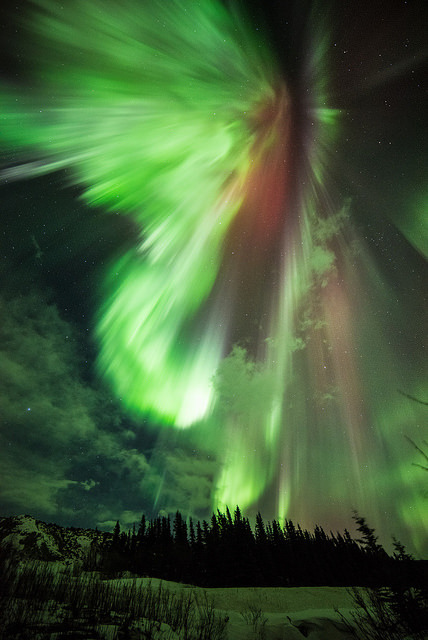
Credit: NASA/THEMIS/Sebastian Saarloos
An Illuminating Aurora
Sometimes during solar magnetic events, solar explosions hurl clouds of magnetized particles into space. Traveling more than a million miles per hour, these coronal mass ejections, or CMEs, made up of hot material called plasma take up to three days to reach Earth. Spacecraft and satellites in the path of CMEs can experience glitches as these plasma clouds pass by. In near-Earth space, magnetic reconnection incites explosions of energy driving charged solar particles to collide with atoms in Earth’s upper atmosphere. We see these collisions near Earth’s polar regions as the aurora. Three spacecraft from our Time History of Events and Macroscale Interactions during Substorms (THEMIS) mission, observed these outbursts known as substorms.

Credit: NASA/Hubble Space Telescope//ESA/STScI
A Shining Supermassive Merger
Every galaxy has a black hole at its center. Usually they are quiet, without gas accretions, like the one in our Milky Way. But if a star creeps too close to the black hole, the gravitational tides can rip away the star’s gaseous matter. Like water spinning around a drain, the gas swirls into a disk around the black hole at such speeds that it heats to millions of degrees. As an inner ring of gas spins into the black hole, gas particles shoot outward from the black hole’s polar regions. Like bullets shot from a rifle, they zoom through the jets at velocities close to the speed of light. Astronomers using our Hubble Space Telescope observed correlations between supermassive black holes and an event similar to tidal disruption, pictured above in the Centaurus A galaxy.

Credit: NASA/Hubble Space Telescope/ESA
A Stellar Explosion
Supernovae can occur one of two ways. The first occurs when a white dwarf—the remains of a dead star—passes so close to a living star that its matter leaks into the white dwarf. This causes a catastrophic explosion. However most people understand supernovae as the death of a massive star. When the star runs out of fuel toward the end of its life, the gravity at its heart sucks the surrounding mass into its center. At the turn of the 19th century, the binary star system Eta Carinae was faint and undistinguished. Our Hubble Telescope captured this image of Eta Carinae, binary star system. The larger of the two stars in the Eta Carinae system is a huge and unstable star that is nearing the end of its life, and the event that the 19th century astronomers observed was a stellar near-death experience. Scientists call these outbursts supernova impostor events, because they appear similar to supernovae but stop just short of destroying their star.

Credit: NASA/GSFC/SDO
An Eye-Catching Eruption
Extremely energetic objects permeate the universe. But close to home, the Sun produces its own dazzling lightshow, producing the largest explosions in our solar system and driving powerful solar storms.. When solar activity contorts and realigns the Sun’s magnetic fields, vast amounts of energy can be driven into space. This phenomenon can create a sudden flash of light—a solar flare.The above picture features a filament eruption on the Sun, accompanied by solar flares captured by our Solar Dynamics Observatory.
Make sure to follow us on Tumblr for your regular dose of space: http://nasa.tumblr.com

As Neil Armstrong became the first human to step foot onto another world on July 20, 1969, lunar dust collected on the boots of his spacesuit. He peered through the gold coating of his visor and looked out across the surface of the Moon, an entirely different landscape than he was used to.
Now, just in time for the 50th anniversary of the Moon landing, you can experience the boots that stepped in Moon dust and the visor that saw the moonscape up close. Neil Armstrong’s spacesuit from the historic Apollo 11 Moon landing is on display for the first time in 13 years in its new display case in the Wright Brothers & the Invention of the Aerial Age Gallery of the National Air and Space Museum.
This week, you can also watch us salute our Apollo 50th heroes and look forward to our next giant leap for future missions to the Moon and Mars. Tune in to a special two-hour live NASA Television broadcast at 1 p.m. ET on Friday, July 19. Watch the program at www.nasa.gov/live.
Make sure to follow us on Tumblr for your regular dose of space: http://nasa.tumblr.com.

We’re sending people to space this week 🚀 Here’s your chance to ask a past Flight Director in Mission Control your questions!
Ginger Kerrick will be taking your questions in an Answer Time session on Friday, September 27 from 12pm - 1 pm ET here on NASA’s Tumblr! Ginger served as a Flight Director in Mission Control for 11 years and is now the Flight Integration Division Chief at Johnson Space Center. Find out what it’s like to send humans to space and learn more about her position as our first female Hispanic flight director. Make sure to ask your question now by visiting http://nasa.tumblr.com/ask!
Ginger Kerrick, as a child, dreamed of growing up to be either a basketball player or an astronaut. When neither dream came to fruition, Kerrick developed a fresh perspective – best summed up by the phrase “It just wasn’t meant to be” – and later became part of our team, serving in the Mission Control Center at the NASA Johnson Space Center as a Flight Director who has, to date, supported 13 International Space Station and five joint space shuttle missions. It was there that Kerrick, a few years earlier, became the first non-astronaut Capsule Communicator (CapCom), the flight controller that speaks directly to the astronaut crew in space, on behalf of the rest of the Mission Control team.
Today, Ginger Kerrick is the Flight Integration Division Chief at our Johnson Space Center. Her department is responsible for crew safety and training, among a list of other duties. She has worked for NASA since 1994, and interned here while she was earning a bachelor’s degree in physics from Texas Tech University. She also has a master’s degree in physics from the university.
Make sure to follow us on Tumblr for your regular dose of space: http://nasa.tumblr.com
Scott Kelly Was the First To…

Astronaut Scott Kelly returned home from his year in space mission on March 1. Spending that much time in space allowed him to rack up some pretty cool milestones. Here are some of his awesome “firsts”:
Firsts on Social Media

While in space, Scott Kelly had the opportunity to host the first NASA TweetChat from space.

The first ever Tumblr AnswerTime from space was hosted by Scott Kelly during his One Year Mission.

Scott Kelly hosted the first NASA Reddit AMA from space.

Before leaving for his year in space, President Obama asked him to Instagram his time on orbit…a Presidential request to Instagram is a first!
Firsts for Scott

During his year in space, Scott conducted his first spacewalk. He hadn’t spacewalked on any of his previous missions, but did so three times during the One Year Mission.
Firsts for an American Astronaut

Most notably, Scott Kelly is the first U.S. astronaut to spend a year in space. His time on orbit also allowed us to conduct the first ever Twins Study on the space station. While Scott was in space, his twin brother Mark Kelly was on Earth. Since their genetic makeup is as close to identical as we can get, this allows a unique research perspective. We can now compare all of the results from Scott in space to his brother Mark on Earth.

During his year in space, Scott had the opportunity to be one of the first astronauts to harvest and eat lettuce grown in the space station’s VEGGIE facility.

Space flowers! Scott was also one of the firsts to help grow and harvest zinnia flowers in the VEGGIE facility. Growing flowering plants in space will help scientists learn more about growing crops for deep-space missions and our journey to Mars.
Make sure to follow us on Tumblr for your regular dose of space: http://nasa.tumblr.com
-
 watch reblogged this · 1 year ago
watch reblogged this · 1 year ago -
 unknown-uwoit liked this · 5 years ago
unknown-uwoit liked this · 5 years ago -
 ghost-ghost-13 liked this · 5 years ago
ghost-ghost-13 liked this · 5 years ago -
 insertanonymousname liked this · 5 years ago
insertanonymousname liked this · 5 years ago -
 weepingit liked this · 5 years ago
weepingit liked this · 5 years ago -
 lennoxs liked this · 5 years ago
lennoxs liked this · 5 years ago -
 lucmarcou liked this · 5 years ago
lucmarcou liked this · 5 years ago -
 adt-space reblogged this · 5 years ago
adt-space reblogged this · 5 years ago -
 bi-streetcat liked this · 5 years ago
bi-streetcat liked this · 5 years ago -
 passionatedisdain liked this · 5 years ago
passionatedisdain liked this · 5 years ago -
 fellowitch liked this · 5 years ago
fellowitch liked this · 5 years ago -
 carefry liked this · 5 years ago
carefry liked this · 5 years ago -
 delicatemusictale liked this · 5 years ago
delicatemusictale liked this · 5 years ago -
 malecus liked this · 5 years ago
malecus liked this · 5 years ago -
 yaksposts liked this · 5 years ago
yaksposts liked this · 5 years ago -
 blaineyandthejets liked this · 5 years ago
blaineyandthejets liked this · 5 years ago -
 ibeliveinfiction liked this · 5 years ago
ibeliveinfiction liked this · 5 years ago -
 walkinginglassshoes liked this · 5 years ago
walkinginglassshoes liked this · 5 years ago -
 earlcht liked this · 5 years ago
earlcht liked this · 5 years ago -
 vindicatedpollyanna liked this · 5 years ago
vindicatedpollyanna liked this · 5 years ago -
 theunoriginaldaisy liked this · 5 years ago
theunoriginaldaisy liked this · 5 years ago -
 cool-username-here-m8-blog liked this · 5 years ago
cool-username-here-m8-blog liked this · 5 years ago -
 truthoradair101 liked this · 5 years ago
truthoradair101 liked this · 5 years ago
Explore the universe and discover our home planet with the official NASA Tumblr account
1K posts